Black & Decker LST1018 User Manual
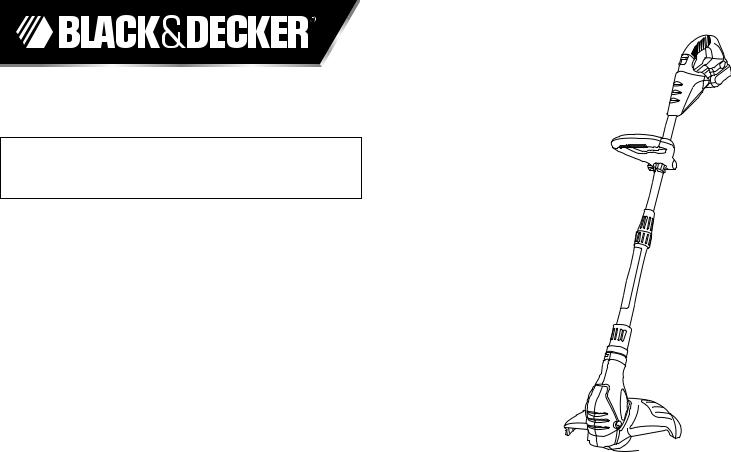
CORDLESS 18 V TRIMMER/EDGER
INSTRUCTIONCatalog Number MANUALLST1018
Thankyou forchoosingBlack& Decker!Go to www.BlackandDecker.com/NewOwner to register your new product. PLEASE READ BEFORE RETURNING THIS PRODUCT FOR ANY REASON:
If you have a question or experiencea problem
HTTP://WWWwith.BLACKANDDECKERyour Black & Decker purchase,.COM/INSTANTANSWERSgo to
for instant answers 24 hours a day.
If you can’t find the answer or do not have access to the internet, call 1-800-544-6986from 8 a.m. to 5 p.m. EST Mon. -- Fri. to speak with an agent. Please have the catalog number available when you call.
SAVE THIS MANUAL FOR FUTURE REFERENCE.
VEA EL ESPAÑOL EN LA CONTRAPORTADA.
POURINSTRUCTIVOLE FRANÇAIS,DE OPERACIÓN,VOIR LA COUVERTURECENTROSARRIÈREDE SERVICIOY. PÓLIZA DE GARANTÍA. ADVERTENCIA: LÉASE ESTE INSTRUCTIVO ANTES DE USAR EL PRODUCTO.
KEY INFORMATION YOU
SHOULD KNOW:
• Charge battery for 45-50 min. before attempting to use your trimmer/edger.
• To operate the trimmer,the lock out button must be pulled back.
• This is an automatic feed trimmer – Do not bump head against ground.
• Use only 0.065 inch diameter line.
• Install guard.
• Phillips screwdriver required (not supplied) to install guard.
• For trouble free feeding and best results, only use Black & Decker replacement spools with single 0.065 inch line. Black & Decker replacement spool model number AF-100.
1
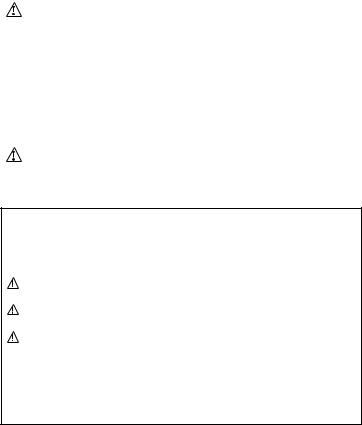
WARNING: Important Safety
Warnings and Instructions
•TOReadREDUCEall instructionsRISK OFbeforeINJURY:operating product. Failure to follow all instructions listed below may result in electric shock, fire and or serious injury.
• Save these instructions and review frequently prior to use and in instructing others.
• KeepWARNINGlong hair and loose clothing away from openings and moving parts. :
When using electric gardening
appliances, basic safety precautions should always be followed to reduce risk of fire, electric shock, and personal injury, including the following.
SAFETYIt is importantGUIDELINESfor you to read and- understandDEFINITIONSthis manual. The information it contains relates to protecting YOUR SAFETY and PREVENTING PROBLEMS. The symbols below are used to help you recognize this information.
DANGER: Indicates an imminently hazardous situation which, if not avoided, will result in death or serious injury.
WARNING: Indicates a potentially hazardous situation which, if not avoided, could result in death or serious injury.
CAUTION: Indicates a potentially hazardous situation which, if not avoided, may result in minor or moderate injury.
CAUTION: Used without the safety alert symbol indicates a potentially hazardous situation which, if not avoided, may result in property damage.
 GENERAL SAFETY WARNINGS AND
GENERAL SAFETY WARNINGS AND
INSTRUCTIONS FOR ALL TOOLS |
|
• READ all instructions. |
|
• A BATTERY OPERATED UNIT with integral batteries or a separate |
|
|
battery pack must be recharged only with the specified charger for |
|
the battery. A charger that may be suitable for one type of battery |
• |
may create a risk of fire when used with another battery. |
US E BATTE RY OP ER ATED UN IT ON LY wi th spe cif ica ll y |
|
|
designated battery pack. Use of any other batteries may create a |
• |
risk of fire. |
AVOID accidental starting. Be sure switch is in the locked or off |
|
|
position before inserting battery pack. Carrying units with your finger |
|
on the switch or inserting the battery pack into a unit with the switch |
|
on invites accidents. |
• DO NOT use unit if switch does not turn it on or off. A unit that cannot |
|
|
be controlled with the switch is dangerous and must be repaired. |
• DISCONNECT battery pack from unit or place the switch in the |
|
|
locked or off position before making any adjustments, changing |
|
accessories, or storing the unit. Such preventative safety measures |
|
reduce the risk of starting the unit accidentally. |
• ALWAYS use safety glasses. Everyday eyeglassesare NOT safety |
|
|
glasses. Also use face or dust mask if trimming operation is dusty. |
|
ALWAYS WEAR CERTIFIED SAFETY EQUIPMENT: |
|
• ANSI Z87.1 eye protection (CAN/CSA Z94.3), |
|
• ANSI S12.6 (S3.19) hearing protection, |
|
• NIOSH/OSHA respiratory protection. |
• GUARD – Do not use this unit without guard attached. |
|
• |
DRESS PROPERLY – Do not wear loose clothing or jewelry. They |
|
can be caught in moving parts. Rubber gloves and substantial rubber |
|
soled footwear are recommended when working outdoors. |
|
• Donʼt operate the unit when barefoot or wearing open sandals. |
|
Wear long pants to protect your legs. Wear protective hair |
2 |
covering to contain long hair. |
|

• NYLON LINE – Keep face, hands and feet clear of rotating nylon |
|
|
line at all times. |
• THE ROTATING LINE PERFORMS A CUTTING FUNCTION – Use |
|
|
care when trimming around screens and desirable plantings. |
• KEEP CHILDREN AWAY – All visit ors should be kept at safe |
|
• |
WARNING: Make sure that other persons and pets |
|
distance from work area. |
are atWARNINGleast 100 feet (30.5m) away.
• : Toreduce the risk of rebound (ricochet) injury, work going away from any nearby solid object such as a wall, steps, large stone, tree, etc. Use great care when working close to solid objects, and, where necessary, do trimming by hand.
• AVOID ACCIDENTALLYSTARTING – Donʼt carry unit with finger on trigger.
• DO NOT FORCE THE APPLIANCE – It will do the job better and with less likelihood of a risk of injury at the rate for which it was designed.
• USE THE RIGHT APPLIANCE – Do not use this unit for any job except that for which it is intended.
• DONʼT OVERREACH – Keep properfootingand balanceat all times.
• DAMAGE TO APPLIANCE – If you strike or become entangled with a foreign object, stop tool immediately,check for damage and have any damage repaired before further operation is attempted. Do not operate with a broken hub or spool.
• AVOID DANGEROUS ENVIRONMENTALCONDITIONS – Do not use electric units in damp or wet locations. Donʼt use the unit in the rain.
• DO NOT OPERATE trimmer in gaseous or explosive atmospheres. Motors intheseunitsnormallyspark,and thesparksmightignitefumes.
• STORE IDLE APPLIANCES INDOORS – When not in use, units should be stored indoors in a dry locked-up place out of reach of children.
• STAYALERT– Watch what you are doing. Use common sense. Do not operate unit when you are tired.
• MAINTAIN APPLIANCES WITH CARE – Keep cutting edge sharp and clean for best performance and to reduce the risk of injury. Follow instructions for lubricating and changing accessories. Inspect appliance cord periodically,and if damaged, have it repaired by an authorized service facility. Inspect extension cords periodically and replace if damaged. Keep handles dry, clean, and free from oil and grease.
• CHECK DAMAGED PARTS – Before further use of the unit, a guard or other part that is damaged should be carefully checked to determine that it will operate properly and perform its intended function. Check for alignment of moving parts, binding of moving parts, breakage of parts, mounting, and any other condition that may affect its operation. A guard or other part that is damaged should be properly repaired or replaced by an authorized service center unless otherwise indicated elsewhere in this manual.
• KEEP GUARDS IN PLACE AND IN WORKING ORDER.
SAVE THESE INSTRUCTIONS
ADDITIONAL IMPORTANT SAFETY
INSTRUCTIONS
• AVOID DANGEROUS ENVIRONMENT – Do not use or charge battery in damp or wet locations.
• DO NOT USE OR CHARGE battery in rain.
• REMOVE BATTERY before servicing, cleaning or removing material from the trimmer. Remove battery from your trimmer and carry by the front handle when not in use.
• EXERCISE CARE in handling batteries in order not to short the battery with conducting materials such as rings, bracelets and keys. The battery or conductor may overheat and cause burns.
• DO NOT OPEN OR MUTILATE the batteries. Released electrolyte isWARNINGcorrosive and may cause damage to the eyes or skin. It may be toxic if swallowed. :
Some dust created by this product
3 contains chemicals known to the State of California to cause cancer,

birth defects or other reproductive harm. Some examples of these chemicals are:
• compounds in fertilizers
• compounds in insecticides, herbicides and pesticides
• arsenic and chromium from chemically treated lumber To reduce your exposure to these chemicals, wear approved safety equipment such as dust masks that are specially designed to filter out microscopic particles.
SAVEWARNINGTHESE: INSTRUCTIONS
Fire hazard. Do not store or carry battery so that metal objects can contact exposed battery terminals. For example, do not place battery in aprons, pockets, tool boxes, product kit boxes, drawers, etc., with loose nails, screws, keys, etc. Transporting batteries can possibly cause fires if the battery terminals inadvertently come in contact with conductive materials such as keys, coins, hand tools and the like. The US Department of Transportation Hazardous Material Regulations (HMR) actually prohibit transporting batteries in commerce or on airplanes (i.e., packed in suitcases and carry-on luggage) UNLESS they are properly protected from short circuits. So when transportingindividual batteries, make sure that the battery terminals are protected and well insulatedfrom materials that couldcontactthemandcausea shortcircuit.
BATTERY CAP INFORMATION
Battery Cap
Battery storage and carrying caps are provided for use whenever the battery is out of the tool or charger.
Remove cap before placing battery in charger or tool.
Extension Cord
Make sure your extension cord is in good condition. When using an extension cord be sure it is heavy enough to carry the current your product will draw. An undersized extension cord will cause a drop in line voltage resulting in loss of power and overheating. The following table shows the correct size to use depending on cord length and nameplate ampere rating. If in doubt, use the next heavier gauge. The smaller the gauge number, the heavier the cord.
|
120V |
Minimum Gauge for Cord Sets |
|
|
||||
|
|
0-25 |
26-50 |
51-100 101-150 |
|
|||
|
Volts |
Total Length of Cord in Feet |
|
|
||||
|
240V |
|
0-50 |
51-100 101-200 201-300 |
|
|||
|
More Not more |
American Wire Gauge |
|
|
||||
|
Ampere Rating |
|
|
|
|
|||
|
Than Than |
|
|
|
|
|
||
|
0 |
- |
6 |
18 |
16 |
16 |
14 |
|
|
6 |
- |
10 |
18 |
16 |
14 |
12 |
|
|
10 |
- |
12 |
16 |
16 |
14 |
12 |
|
|
12 |
- |
16 |
14 |
12 |
Not Recommended |
|
|
|
|
|
|
|
|
|
|
|
Double Insulation |
|
|
|
|
|
|||
Double insulated tools are constructed throughout with two |
||||||||
separate layers of electrical insulation or one double thickness |
||||||||
of insulation between you and the toolʼs electrical system. |
||||||||
Tools built with this insulation system are not intended to be |
||||||||
grounded. As a result, your tool is equipped with a two prong |
||||||||
plug which permits you to use extension cords without concern |
||||||||
for maintaining a ground connection. NOTE: Double insulation does |
||||||||
not take the place of normal safety precautions when operating this |
||||||||
tool. The insulation system is for added protection against injury |
||||||||
resulting from a possible electrical insulation failure within the tool. |
||||||||
REPLACEMENT PARTS:When servicing all tools, USE IDENTICAL |
||||||||
REPLACEMENT PARTS.Repair or replace damaged cords. |
||||||||
4
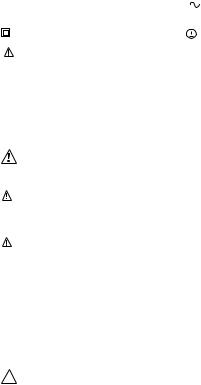
The label on your tool may include the following symbols. |
|||||||
V................ |
|
volts |
A .................... |
amperes |
|||
Hz.............. |
|
hertz |
W .................. |
watts |
|||
min |
. ...........minutes |
no .................. |
alternating current |
||||
|
|
|
..........direct current |
no load speed |
|||
|
|
|
|||||
|
.. |
|
. ...........Class II Construction |
|
|
.................. |
earthing terminal |
|
|
|
|
|
|
||
|
|
|
|
|
|
||
|
|
|
............safety alert symbol |
.../min ............ |
revolutions |
||
|
|
|
|
|
|
|
per minute |
Important Safety Instructions for Battery Chargers |
|||||||
SAVE THESE INSTRUCTIONS: This manual contains important |
|||||||
safety instructions for battery chargers. |
|
||||||
• Before using charger,read all instructions and cautionary markings |
|||||||
|
|
|
WARNING: Shock hazard. Do not allow any liquid to |
||||
|
|
on charger, battery pack, and product using battery pack. |
|||||
get inside charger. |
|
|
|
|
|||
|
|
CAUTION: Burn hazard. Toreduce the risk of injury,charge only |
|||||
Black & Decker batteries. Other types of batteries may burst causing |
|||||||
personal injury and damage. |
|
|
|
|
|||
|
|
CAUTION: Under certain conditions, with the charger plugged in to |
|||||
the power supply, the charger can be shorted by foreign material. |
|||||||
Foreign materials of a conductive nature such as, but not limited to, |
|||||||
steel wool, aluminum foil, or any buildup of metallic particlesshould be |
|||||||
kept away from charger cavities. Always unplug the charger from the |
|||||||
power supply when there is no battery pack in the cavity.Unplug |
|||||||
charger before attempting to clean. |
|
|
|
|
|||
• |
The charger supplied with this product is intended to be |
||||||
|
|
plugged in such that it is correctly orientated in a vertical or |
|||||
floorWARNINGmount position. :
•  DO NOT attempt to charge the battery pack with any chargers
DO NOT attempt to charge the battery pack with any chargers
•
•
•
•
•
•
•
•
•
•
5 •
other than the ones in this manual. The charger and battery pack are specifically designed to work together.
These chargers are not intended for any uses other than charging Black&Decker rechargeable batteries. Any other uses may result in risk of fire, electric shock or electrocution.
Do not expose charger to rain or snow.
Pull by plug rather than cord when disconnecting charger.
This will reduce risk of damage to electric plug and cord.
Make sure that cord is located so that it will not be stepped on, tripped over, or otherwise subjected to damage or stress. Do not use an extension cord unless it is absolutely necessary. Use of improper extension cord could result in risk of fire, electric shock, or electrocution.
An extension cord must have adequate wire size (AWG or American Wire Gauge) for safety.The smaller the gauge number of the wire, the greater the capacity of the cable, that is 16 gauge has more capacity than 18 gauge. When using more than one extension to make up the total length, be sure each individual extension contains at least the minimum wire size.
Do not place any object on top of charger or place the charger on a soft surface that might block the ventilation slots and result in excessive internal heat. Place the charger in a position away from any heat source. The charger is ventilated through slots in the top and the sides of the housing.
Do not operate charger with damaged cord or plug — have them replaced immediately.
Do not operate charger if it has received a sharp blow, been dropped, or otherwise damaged in any way. Takeit to an authorized service center.
Do not disassemble charger; take it to an authorized service center when service or repair is required. Incorrect reassembly may result in a risk of electric shock, electrocutionor fire.
Disconnect the charger from the outlet before attempting any

cleaning. This will reduce the risk of electric shock. Removing the battery pack will not reduce this risk.
• NEVER attempt to connect 2 chargers together.
• The charger is designed to operate on standard household electrical power (120 Volts). Do not attempt to use it on any other voltage.
ImportantWARNINGSafety Instructions for Battery Packs
: For safe operation, read this manual and manuals originally supplied with tool before using the charger.
When ordering replacement battery packs, be sure to include catalog number and voltage.
The battery pack is not fully charged out of the carton. Before using the battery pack and charger, read the safety instructions below. Then follow charging procedures outlined.
READ ALL INSTRUCTIONS
• Do not incinerate the battery pack even if it is severely damaged or is completely worn out. The battery pack can explode in a fire.
• Do not charge or use battery in explosive atmospheres, such as in the presence of flammable liquids, gases or dust.
Inserting or removing the battery from the charger may ignite the dust or fumes.
• If battery contents come into contact with the skin, immediately wash area with mild soap and water. If battery liquid gets into the eye, rinse water over the open eye for 15 minutes or until irritation ceases. If medical attention is needed, the battery electrolyte for LI-ION batteries is composed of a mixture of liquid organic carbonates and lithium salts. For NI-CD batteries it is a 25-35% solution of potassium hydroxide.
• Contents of opened battery cells may cause respiratory irritationWARNING. Provide fresh air. If symptoms persists, seek medical attention : Burn hazard. Battery liquid may be
flammable if exposed to spark or flame.
• Charge the battery packs only in Black & Decker chargers.
• DO NOT splash or immerse in water or other liquids.
• Do not store or use the tool and battery pack in locations whereWARNINGthe temperature may reach or exceed 105°F (40˚) (such as outside sheds or metal buildings in summer).
: Never attempt to open the battery pack for any reason. If battery pack case is cracked or damaged, do not insert into charger. Do not crush, drop or damage battery pack. Do not use a battery pack or charger that has received a sharp blow, been dropped, run over or damaged in any way (i.e., pierced with a nail, hit with a hammer, stepped on). Damaged battery packs should be returned to service center for recycling.
CAUTION: When not in use, place tool on its side on a stable surface where it will not cause a tripping or falling hazard. Some tools with large battery packs will stand upright but may be easily knocked over.
STORAGE RECOMMENDATION
1. Store tool:
a.) with the battery pack removed and on the charger. b.) in a place that iscool and dryaway fromdirectsunlight and
excess heator cold.
c.) out of the reach of children.
2. For prolonged storage such as over the winter, the battery pack should be fully charged and then removed from the charger. It should be charged again just prior to use.
6
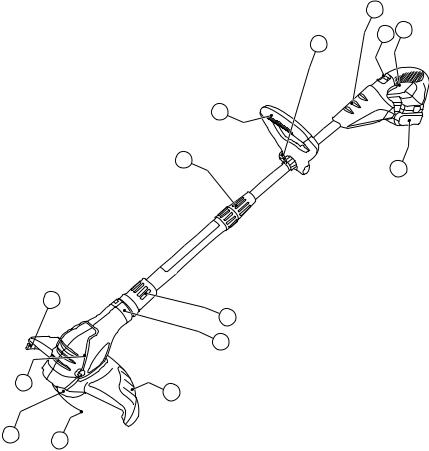
Features |
|
1. |
On/off switch |
2. |
Lock-off button |
3. |
Main handle |
4. |
Secondary handle |
5. |
Handle knob |
6. |
Handle adjustment collar |
7. |
Mode adjustment collar |
8. |
Motor housing |
9. |
Guard |
10. |
Line trimming blade |
11. Edge guide |
|
12. |
Spool housing |
13. |
Cutting line |
14. |
Battery |
|
|
3 |
|
|
5 |
2 |
1 |
|
|
||
|
|
|
|
|
4 |
|
|
6 |
|
|
14 |
|
|
|
|
|
|
10 |
7 |
|
|
|
|
|
|
|
|
|
8 |
|
|
1 |
|
|
|
|
1 |
|
9 |
|
|
|
|
|
1 |
2 |
|
13 |
|
|
|
7 |
||
|
|
|
|
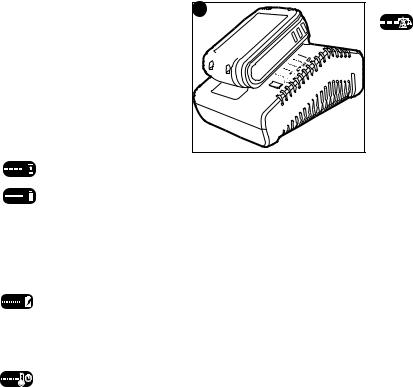
Charging Procedure
This charger will fully charge the 18V Lithium battery in 45-60 minutes, depending on the level of charge in the pack.
1. Plug the charger into an appropriate outlet before inserting the battery pack.
2. Insert the battery pack into the charger. (Fig. B)
3. The LED will flash indicating that the battery is being charged.
4. The completion of charge is indicated by the LED remaining on continuously. The pack is fully charged and may be used at this time or left on the charger.
Charger Diagnostics
This charger is designed to detect certain problems that can arise with the battery packs or the power source. Problems are indicated by one LED flashing in different patterns.
Bad battery
The charger can detect a weak or damaged battery. The LED flashes in the pattern indicated on the label. If you see this bad battery blink pattern, do not continue to charge the battery. Return it to a service center or a collection site for recycling.
Hot/Cold pack delay
When the charger detects a battery that is excessively hot or excessively cold, it automatically starts a Hot/Cold Pack
Delay, suspending charging until the battery has normalized. After this happens, the charger automatically switches to the Pack Charging mode. This feature ensures maximum battery life. The light flashes in the pattern indicated on the label.
Problem power line
When the charger is used with some portable power sources such as generators or sources that convert DC to AC, the charger may temporarily suspend operation. The LED flashes in the pattern indicated on the label. This indicates that the power source is out of limits.
Leaving the battery in the charger
The charger and battery pack can be left connected with the LED glowing indefinitely. The charger will keep the battery pack fresh and fully charged. This charger features an automatic tune-up mode which equals or balances the individual cells in the battery pack to allow it to function at peak capacity.
Important Charging Notes
1. Longest life and best performance can be obtained if the battery pack is charged when the air temperature is between 65°F and 75°F (18°- 24°C). DO NOT charge the battery pack in an air temperature below +40°F (+4.5°C), or above +105°F (+40.5°C). This is important and will prevent serious damage to the battery pack.
2. The charger and battery pack may become warm to touch while charging. This is a normal condition, and does not indicate a problem. To facilitate the cooling of the battery pack after use, avoid placing the charger or battery pack in a warm environment such as in a metal shed, or an uninsulated trailer.
3. If the battery pack does not charge properly:
a. Check current at receptacle by plugging in another appliance
b. Check to see if receptacle is connected to a light switch which turns power off when you turn out the lights.
c. Move charger and battery pack to a location where the surrounding air temperature is approximately 65°F - 75°F
8 (18°- 24°C).
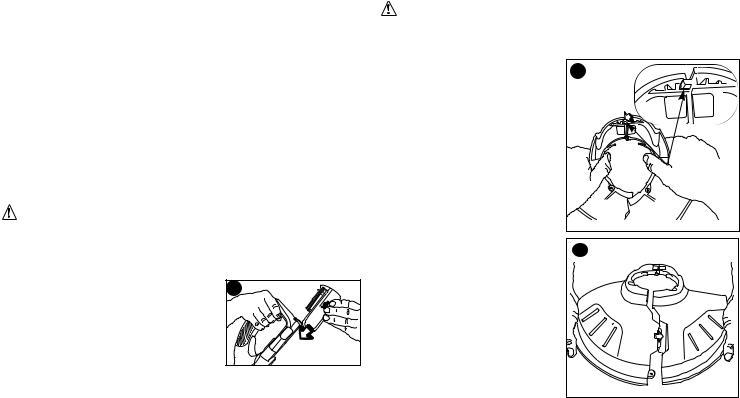
d. If charging problems persist, take the tool, battery pack and charger to your local service center.
4. The battery pack should be recharged when it fails to produce sufficient power on jobs which were easily done previously. DO NOT CONTINUE to use under these conditions. Follow the charging procedure. You may also charge a partially used pack whenever you desire with no adverse affect on the battery pack.
6. Do not freeze or immerse charger in water or any other liquid.  Shock hazard. Do not allow any liquid
Shock hazard. Do not allow any liquid
5. Foreign materials of a conductive nature such as, but not limited to, steel wool, aluminum foil, or any buildup of metallic particles should be kept away from charger cavities. Always unplug the charger from the power supply when there is no battery pack in the cavityWARNING:. Unplug charger before attempting to clean.
to get inside charger.Never attempt to open the battery pack for any reason. If the plastic housing of the battery pack breaks or cracks, return to a service center for recycling.
ASSEMBLY
WARNING: Before assembly, remove the battery from the tool.
FITTING AND REMOVING THE
BATTERY (FIGURE C)
• To fit the battery, line it up with the receptacle on the tool. Slide the battery into the receptacle and push until the battery snaps into place.
• To remove the battery, push the release button while at the same time pulling the battery out of the receptacle.
ASSEMBLING AND ATTACHING THE TWO PIECE |
||
GUARD |
|
|
• |
Phillips screwdriver required (not supplied) to install guard. |
|
|
WARNING: Remove battery pack from tool before |
|
attempting to attach the guard or make any adjustment. NEVER |
||
OPERATE TOOL WITHOUT GUARD FIRMLYIN PLACE. The |
||
guard must always be on the tool to protect the user. |
||
TO ASSEMBLE: |
|
|
• |
Remove the two guard sections |
|
|
from the carton. |
|
• |
Holding the sections as shown |
|
|
in figure D, insert the tab from |
|
|
the first guard section into the |
|
|
slot of the second guard section. |
|
|
See inset. |
Tab |
|
|
|
• Insert the side tab from the first guard section into the slot of the second guard section until you hear them “snap” together (figure E).
9
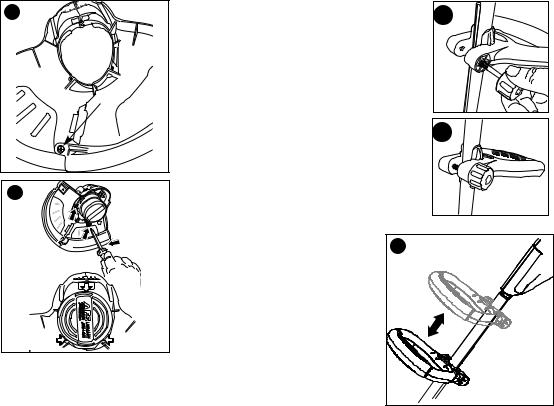
•Insert the 3/4 inch (19mm) screw as shown in figure F to complete the guard assembly.
TO ATTACH:
• Place the assembled guard over the spool as shown in figure G and insert the remaining three screws into the guard as. indicated by the arrows
• Once the guard is installed, remove the covering from the line cut-off blade, located on the edge of the second guard section.
PushAuxilIarythe auxillaryhandlehandleattachmonto thentupper H tube. Position the handle so that the groove
in the tube is located in the middle of the handle opening. Insert the handle bolt through the hole in the handle as shown in figure H and I.
I
AUXILIARY HANDLE ADJUSTMENT
For maximum comfort and control, adjust the auxiliary handle to suit your height (figure J). Shorter users adjust handle to a lower position (away from you) and taller users, adjust handle to an upper position (towards you). The handle should be adjusted so that your front arm is straight as shown in figure M.
10
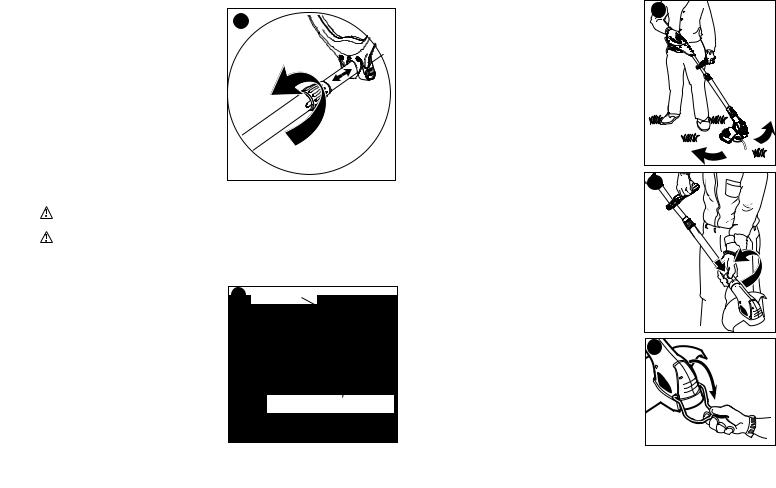
HEIGHT ADJUSTMENT
The overall height of the trimmer can be adjusted by loosening the lock collar and rotating it opposite to the arrow shown in figure K. The tubes can then be extended shorter or longer. When the desired height is achieved tighten the collar by rotating in the direction shown in figure K.
Operating Instructions
CAUTION: ALWAYS WEAR EYE PROTECTION. CAUTION: Inspect area to be trimmed and remove any wire,
cord, or string-like objects which could become entangled in the rotating line or spool. Be particularly careful to avoid any wire which might be bent outwardly into the path of the tool, such as barbs at the base of a chain link fence. Lock-out
OPERATE THE
TRIMMER/EDGER
• Toturn trimmer on, pull the lock out button, shown in figure L, back and, then squeezethe trigger switch. Toturn the tool off, release the trigger.
• Slowly swing trimmer side-to-side as shown in figure M.
• To convert for maintenance edging, turn off the tool. As shown in figure N, hold the trimmer with one hand by the auxiliary handle, grasp the collar and push in direction of arrow and rotate the trimmer head until it stops, (half turn), release your hand, (rotate clockwise when viewed from the switch end). The tool is locked in the edger position.
Rotate the wire edge guide forward and down into place before edging, as shown in figure O.
11
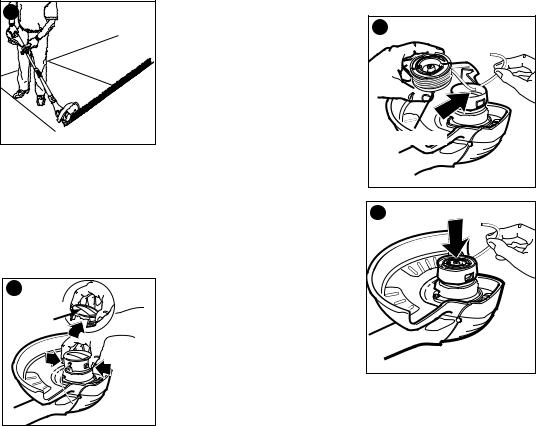
• |
To operate as a maintenanceedger, |
|
|
position trimmer above sidewalkas |
|
• |
shown in figure P. |
|
Return to trimming positionby turning |
|
|
|
the tool off, push in directionof arrow |
|
|
and rotating the trimmer head counter |
|
|
clockwise until it stops.When using |
|
|
the tool in the trimmer mode you may |
|
|
choose to fold the wire edge guideup |
|
|
out of the way. |
|
LINE FEEDING |
|
|
Yourtrimmer uses .065 in. (1.65mm) |
|
|
diameter nylon line to cut grass and weeds quickly and easily.In time, |
||
the tip of the nylon line will become worn and the auto feed |
||
mechanism will automaticallyfeed and trim a fresh length of line. |
||
The cutting line will wear faster if the cutting is done along sidewalks |
||
or other abrasive surfaces or heavier weeds are being cut. The |
||
automatic feed mechanism senses when more cutting line is needed |
||
and feeds and trims the correct length of line whenever it is required. |
||
You donʼt even have to think about it. Do not bump unit on ground in |
||
attempt to feed line or for any other purpose. |
||
REPLACING SPOOL/CLEARING |
|
|
JAMS AND TANGLED LINES |
|
|
From time to time, especially when |
RC-100-P |
|
cutting thick or stalky weeds, the line |
||
feeding hub may become clogged with |
Cap |
|
sap or other material and the line will |
|
|
become jammed as a result. Toclear |
|
|
the jam, follow the steps listed below. |
|
|
• |
Turn off the trimmer and removethe |
|
• |
battery. |
|
Press the release tabs on the line |
|
|
|
spool cover,as shownin figure Q |
|
|
and remove the cover by pullingit |
|
|
straight off. |
|
|
|
12 |
•Lift the spool of nylon line out of the hub and clear any broken line or
•cutting debris from the spool area. In case of jams and tangled line unwrap about one foot (30cm) of line to ensure that it is undamaged. If it is OK rewind it and insert the line end through the eyelet in the
spool hub, as shown in figure R. 


|
AF-100 Spool |
• |
Pull the line through the hole to |
|
maintain tension while placing the |
|
spool downintothehub withthe |
|
notched sideexposed,as shownin |
• |
figure S. |
Press the spool down GENTLY |
|
|
and rotate it until you feel it drop |
|
into place.(When in place,thespool |
|
will turn a few degrees leftandright |
• |
freely.) |
Snap the spool cover back on, |
|
|
insert the battery and turn the tool |
|
on. In a few seconds or less youʼll |
|
hear the nylon line being cut |
|
automatically to the proper length. |
• For trouble free feeding and best results, only use Black & Decker |
|
|
replacement spools with single 0.065 inch line. Black & Decker |
|
replacement model number AF-100. |
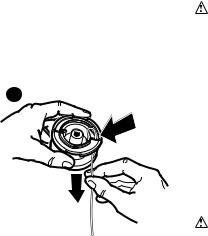
REWINDING SPOOL FROM BULK LINE (USE ONLY.065 IN. |
||
DIAMETER LINE) |
||
Bulk line is also available for purchase from your local retailer. |
||
NOTE: Hand wound spools from bulk line are likely to become |
||
tangled more frequently than Black & Decker factory wound spools. |
||
To install bulk line, follow the steps below. |
||
• |
Turn off the trimmer and remove the battery. |
|
• |
Press the release tabs on the line spoolcover,as shownin figureQ |
|
• |
and remove the coverby pullingit straightoff. |
|
Remove the spool from the tool and removeand discardall line on the |
||
• |
spool. |
|
Insert one end of the bulk line into |
|
|
|
the hole in the spool shownin |
|
• |
figureT about 1/2 in. (12mm). |
|
Hold the line in the hole and pull |
|
|
|
the rest of the line through the slot |
|
• |
in the spool, shown in figure T. |
|
Snugly and evenlywind the bulk line |
|
|
|
onto the spool in the directionof the |
|
|
arrow on spoolin figure T until it is |
|
• |
nearly full. |
|
Insert the line end throughthe eyelet |
|
|
|
in the spoolhub,as shownin |
|
|
figure R. Pullthe line throughthe |
|
|
holeto maintain tension while |
|
|
|
|
|
placingthe spooldown intothe hub |
|
• |
with the notched side exposed,as shownin figureS. |
|
Press the spool down GENTLY and rotateit untilyou feel it drop into |
||
• |
place. (When in place,thespoolwillturna fewdegrees leftandrightfreely.) |
|
Snap the spoolcoverback on, insertthe batteryand turn the tool on. |
||
|
In a few seconds or less youʼll hear the nylon line being cut |
|
|
automatically to the proper length. |
|
Maintenance |
|
• |
Use only mild soap and damp cloth to clean the tool. Never let any |
• |
liquid get inside the tool; never immerse any part of the tool into a |
WARNING: Remove or disconnect battery before |
|
|
liquid. |
|
servicing, cleaning or removing material from the gardening appliance. |
Accessories |
|
• |
Recommended accessories for use with your tool are available from |
|
your local dealer or authorized service center. If you need assistance |
• |
regarding accessories, please call: 1-800-544-6986. |
Use Black & Decker replacement spool No. AF-100. |
|
• Spool cap replacement part no. RC-100-P. |
|
• |
Reload nylon line (either bulk or prewrapped replacement spool) as |
• |
shown in this manual. |
USE ONLY.065 in. (1.65mm) DIAMETER NYLON MONOFILAMENT |
|
|
LINE. Heavier line will overload the motor, cause overheating and will |
|
impair the automatic feed. This line is available at your local dealer or |
• |
authorized service center. |
WARNING: The use of any accessory not |
|
• |
Do not use fishing line or other lines that are not recommended. |
recommended for use with this tool could be hazardous.
IMPORTANT
Toassure product SAFETY and RELIABILITY,repairs, maintenance and adjustment should be performed by authorized service centers or other qualified service organizations, always using identical replacement parts.
13

The RBRC™ Seal
The RBRC™ (Rechargeable Battery Recycling Corporation) Seal on the lithium-ion battery (or battery pack) indicates that the costs to recycle the battery (or battery pack) at the end of its useful life have already been
paid by Black & Decker. In some areas, it is illegal to place spent lithium-ion batteries in the trash or municipal solid waste stream and the RBRC program provides an environmentally conscious alternative.
RBRC in cooperation with Black & Decker and other battery users, has established programs in the United States and Canada to facilitate the collection of spent lithium-ion batteries. Help protect our environment and conserve natural resources by returning the spent liion battery to an authorized Black & Decker service center for recycling. You may also contact your local recycling center for information on where to drop off the spent battery,or call
1-800-8-BATTERY.
SERVICEAll BlackINFORMATION& Decker Service Centers are staffed with trained personnel to provide customers with efficient and reliable power tool service. Whether you need technical advice, repair, or genuine factory replacement parts, contact the Black & Decker location nearest you. Tofind your local service location, refer to the yellow page directory under "Tools—Electric"or call: 1-800-544-6986 or visit www.blackanddecker.com
FULLBlackTWO& Decker-YEAR(UHOME.S.) IncUSE. warrantsWARRANTYthis product for two years against any defects in material or workmanship. The defective product will be replaced or repaired at no charge in either of two ways.
The first, which will result in exchanges only, is to return the product to the retailer from whom it was purchased (provided that the store is a participating retailer). Returns should be made within the time period of the retailerʼs policy for exchanges (usually 30 to 90 days
14
after the sale). Proof of purchase may be required. Please check with the retailer for their specific return policy regarding returns that are beyond the time set for exchanges.
The second option is to take or send the product (prepaid) to a Black & Decker owned or authorized Service Center for repair or replacement at our option. Proof of purchase may be required. Black & Decker owned and authorized Service Centers are listed under "Tools-Electric" in the yellow pages of the phone directory. This warranty does not apply to accessories. This warranty gives you specific legal rights and you may have other rights which vary from state to state or province to province. Should you have any questions, contact the manager of your nearest Black & Decker Service Center. This product is not intended:for commercial use.
If your warning labels becomeFREE WARNINGillegible orLABELare missing,REPLACEMENTcall for a free replacement. 1-800-544-6986
This warranty does not apply to products sold in LatinATINAmericaAMERICA:. For products sold in Latin America, check country specific warranty information contained in the packaging, call the local company or see the website for warranty information.

TROUBLESHOOTING
|
Problem |
|
Possible Cause |
Possible Solution |
|
|
• |
Line wonʼt feed. |
|
• Line tangled in spool. |
• Unwrap 24 inches (610mm) of line and |
|
|
|
|
|
rewind. |
|
|
|
|
|
|
|
• |
Line fails to cut off. |
|
• Line cutter in guard is damaged or missing. |
• Return to service center for repair. |
|
|
|
|
• Line extends past guard. |
• Rewind or trim line to line cutter. |
|
|
|
|
|
|
|
• |
Unit will not start. |
|
• Battery not installed properly. |
• Check battery installation. |
|
|
|
|
• Battery not charged. |
• Check battery charging requirements. |
|
|
|
|
|
|
|
• |
Battery wonʼt charge. |
|
• Battery not inserted into charger. |
• Insert battery into charger until LED |
|
|
|
|
• Charger not plugged in. |
appears. |
|
|
|
|
• Plug charger into a working outlet. Refer to |
|
|
|
|
|
|
“Important Charging Notes” for more details. |
|
|
|
|
|
• Check current at receptacle by plugging in a |
|
|
|
|
|
lamp or other appliance. |
|
|
|
|
|
• Check to see if receptacle is connected to a |
|
|
|
|
|
light switch which turns power off when you turn |
|
|
|
|
• Surrounding air temperature too hot or too cold. |
out the lights. |
|
|
|
|
• Move charger and tool to a surrounding air |
|
|
|
|
|
|
temperature of above 40 degree F(4.5°C) or |
|
|
|
|
|
below 105 degree F (+40.5°C). |
|
|
For assistance, visit our website |
www.blackanddecker.com for the location of the service center nearest you or call the BLACK & |
||
|
|
DECKER help line at |
1-800-544-6986. |
|
|
|
|
|
|
Imported by |
|
|
|
|
|
Black & Decker (U.S.) Inc., |
See ‘Tools-Electric’ |
|
|
|
|
701 E. Joppa Rd. |
– Yellow Pages – |
|
|
|
|
Towson, MD 21286 U.S.A. |
for Service & Sales |
|
|
|
15 |
|
|
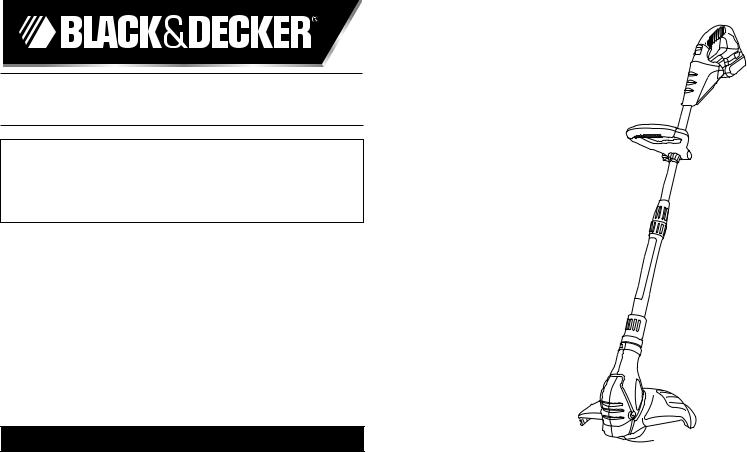
LST1018 TAILLE-BORDURE/COUPE BORDURE - MODE D’EMPLOI
Merci d’avoir choisi Black & Decker! Consulter le site Web www.BlackandDecker.com/NewOwner pour enregistrer votre nouveau produit.
ALIREAVANT DERETOURNER CE PRODUIT POUR QUELQUE RAISON QUE CE SOIT :
Si des questions ou des problèmes surgissent après lʼachat dʼun produit Black & Decker, consulter le site Web
HTTP://WWW.BLACKANDDECKER.COM/INSTANTANSWERS
Sipourla réponseobtenir desest introuvableréponses instantanémentou en lʼabsencedʼaccèsà24 heures parInternet,jour. composer le 1-800-544-6986de 8 h à 17 h HNE, du lundi au vendredi, pour parler avec un agent.
CONSERVERCEPrière d’avoir le numéroMANUELPOURde cataloguesousUNlaUSAGEmain lorsULTERIEURde l’appel. .
RENSEIGNEMENTS
IMPORTANTS
• Charger lʼensemble de piles pendant 45 à 60 minutes avant dʼutiliser le coupe-bordure.
• Il faut pousser le bouton de verrouillage vers lʼarrière afin dʼutiliser le coupe-bordure.
• Lʼalimentation du coupe-bordure est automatique; il ne faut pas en frapper la tête contre le sol.
• Utiliser seulement du fil de 1,65 mm (0,065 po) de diamètre.
• Installer le protecteur.
• Tournevis à pointe cruciforme requis (non fourni) pour installer un pare-main.
• Pour obtenir une alimentationdu fil sans tracas et des résultats optimaux, utiliser uniquementles bobines de rechange Black &
Decker pourvues dʼun fil unique de 1,65 mm (0,065 po). Le numéro de modèle de la bobine de rechange
Black & Decker est
16 AF-100.
